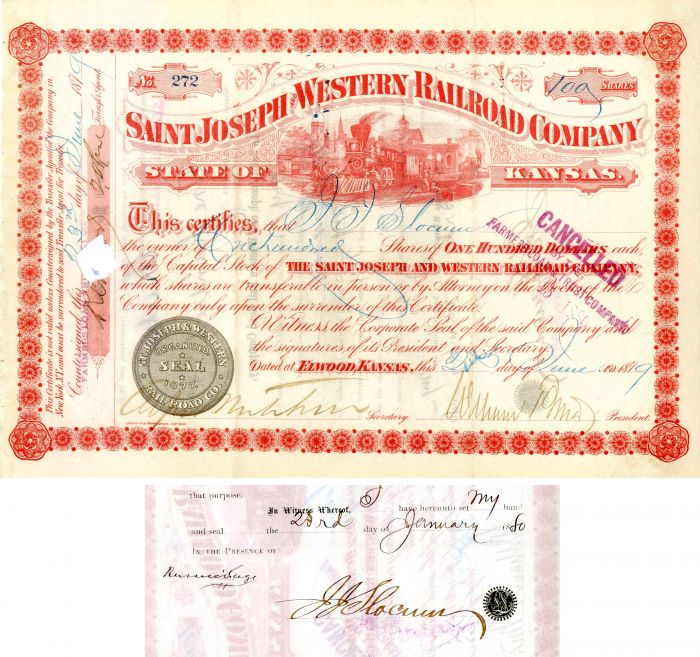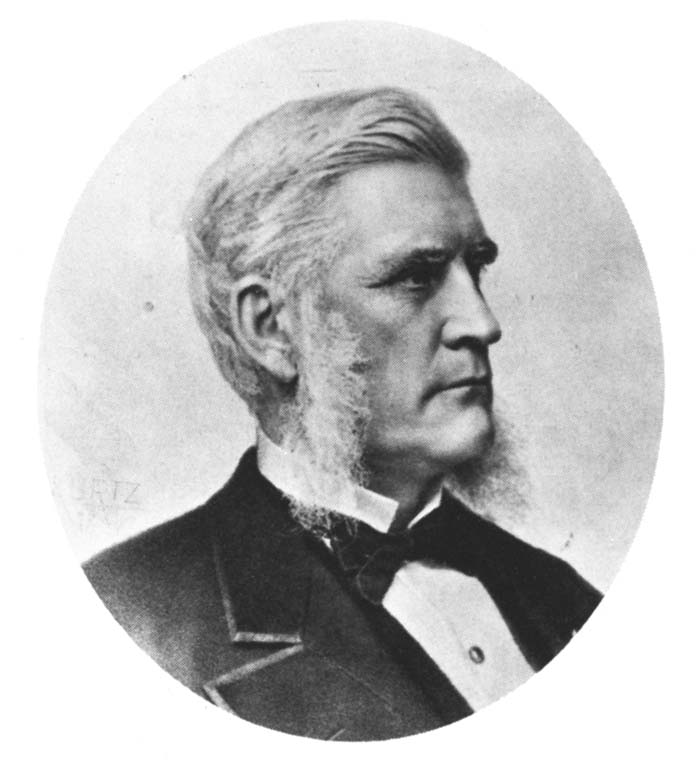Saint Joseph and Western Railroad Co. signed by Russell Sage and J.J. Slocum - Stock Certificate
Inv# AG1988 Stock
Stock signed by Russell Sage as witness on back and transferred to Sidney Dillon. Also issued to and signed on back by J.J. Slocum. Further research needed on Slocum.

Russell Sage (1816-1906) Banker; Financier; U.S. Congressman. As the originator of "put and call options", Sage greatly changed the way speculators played the stock market. Among America's most powerful and wealthy bankers, he financed Jay Gould and made a vast fortune on the latter's stock manipulations. "Sage was one of the shrewdest and most conservative of all great financiers." At one time he is said to have had $27,000,000 out on call loans. At the time of his death he left a fortune worth an estimated $70,000,000. Sage was born in the Mohawk Valley and came to Troy to work in his brother’s dry goods store. He became an important figure in Troy, elected to several offices. But he soon expanded beyond Troy. His first wife, Maria, was an Emma Willard graduate but died early and childless. He sought another wife who might be another Emma graduate and whose family would give him proper credentials. His second wife was Margaret Olivia Slocum, who fit all his requirements. They moved to New York City, to a mansion on 5th Avenue, and Russell became allied with Jay Gould. Together they were part of a group which the history books call "robber barons". The Sage-Gould duo bought railroads all over America, including the famous elevated railroad in NYC. They became big investors in the stock market, where it is said Sage invented "puts" and "calls". Sage died in the early 1900’s as perhaps the "19th wealthiest American ever", according to a Fortune publication of the "100 richest" people ever in the American millennium craze pre-2000. Sage died childless, leaving his widow, Margaret Olivia Slocum Sage, the wealthiest woman in America. She chose to be buried in Syracuse with her parents, but was noted as a major philanthropist nation-wide. It has been said that she endowed causes and institutions which her husband would have opposed, such as higher education in general and education for females. A major national cartoon from the early 1900’s shows "Uncle Sam" behind a bank teller’s window, collecting the first national income tax payments. First in line is Russell Sage, a well-known miser, having a hard time getting his payment out of his pocket. Behind him is Hetty Green, another famous miser, known as "the Witch of Wall Street". Last in line is Jay Gould, Russell Sage’s colleague. All are very unhappy to be paying the U. S. any money. Sage’s wife, Margaret, buried him in a Greco-Roman mausoleum by himself, without his name on it, and with a Medusa’s head, snakes and all, carved on a small marble bench next to the mausoleum.

Sidney Dillon (1812-1892) Railroad executive , born in Northampton, New York. He left his impoverished family farm at age seven to work as a water boy on railroad construction sites, and progressed to overseer and foreman. One of America's premier railroad builders, Dillon began his career in the industry working as a water boy on the Mohawk and Hudson, one of America's earliest railroads. In 1840 his bid was accepted to build a small section of the Boston & Albany Railroad. This job launched his railroad career, which included becoming the major contractor for the Union Pacific Railroad. He was actively involved in the construction of numerous roads, his largest being the Union Pacific, with which he became actively involved in 1865 through a stock purchased in the Credit Mobilier. As one of the principal contractors for the Union Pacific, Dillon's vast experience in the construction of railroads proved invaluable. He took part in the laying of the last rail in 1869 and received one of the ceremonial silver spikes used to complete the project. He served as director of the Union Pacific (1864–92) and twice as its president (1874–84, 1890–2). He wrote ‘Historic Moments: Driving the Last Spike of the Union Pacific’, published posthumously in Scribner's magazine (Aug 1892). Following 1870, Dillon was primarily known as a financier, becoming involved with Jay Gould in numerous ventures as well as serving on the board of directors of the Western Union Telegraph Co.
A stock certificate is issued by businesses, usually companies. A stock is part of the permanent finance of a business. Normally, they are never repaid, and the investor can recover his/her money only by selling to another investor. Most stocks, or also called shares, earn dividends, at the business's discretion, depending on how well it has traded. A stockholder or shareholder is a part-owner of the business that issued the stock certificates.










Ebay ID: labarre_galleries